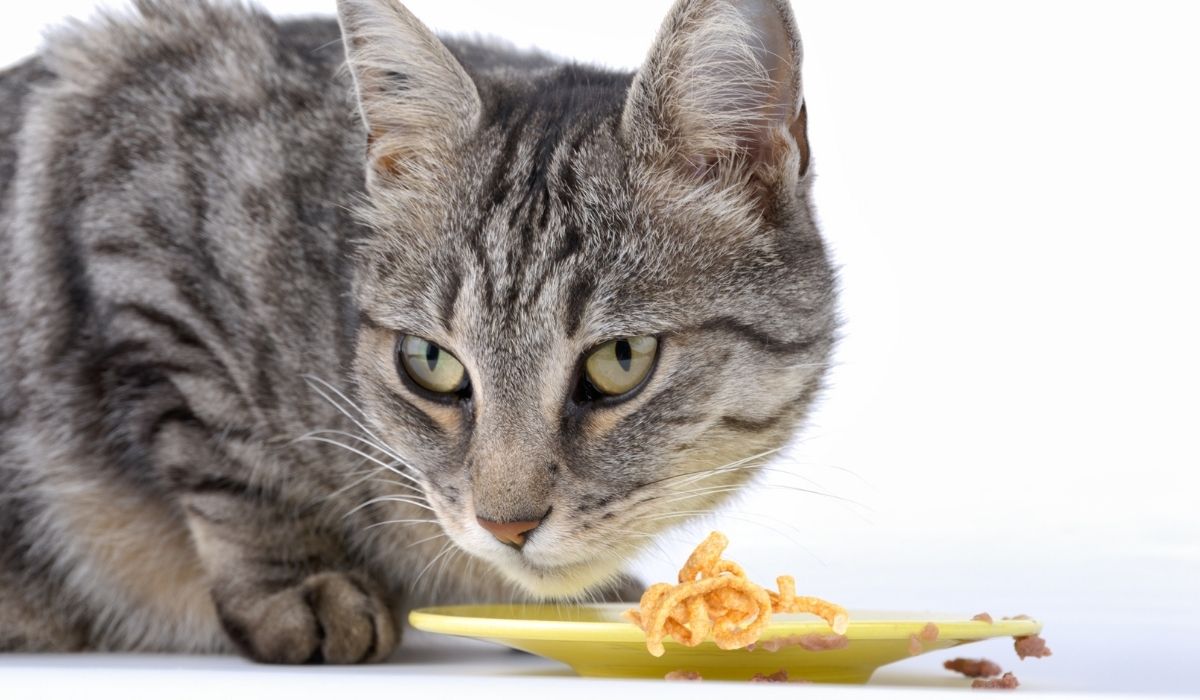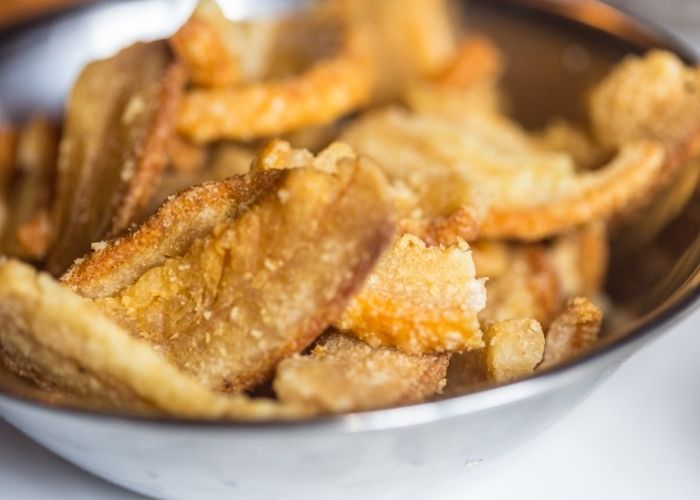Carnivores will eat every part of an animal to ensure they get all the meaty goodness, but can cats eat pork rinds?
You can serve your kitty pork occasionally, but not every part of this animal is good for them, although safe. If your cats are like mine, they’ve probably made you feel guilty for not sharing your pork rinds with them!
IMPORTANT: At stuffaboutcats.com, we regularly consult with licensed veterinarians and other industry experts. However, the information found on stuffaboutcats.com should not be viewed as veterinary advice. We do our best to help you better understand your cats, but the information on this blog is not a substitute for veterinary guidance.
I aim to only feed my felines food that’s good for them, so when they kept asking me for a bite of pork rind, I decided to look this protein up.
In this article, I share what I found out about the safety of pork rinds for cats and why it’s essential to include healthy fats in their diet.
Can Cats Eat Pork Rinds?
Pork rinds are the skin of a pig and can be cooked in many ways. In general, pork is safe for cats to eat, but what about this part?
If your kitty purrs when they smell the scent of lard, you’ll be glad to know that you can safely share a piece with them. Pork rinds are non-toxic to cats, but they should only consume in moderation.
When Are Pork Rinds Okay For Cats To Eat?
You should never give your cat raw pork or rinds to eat. Pork rinds must be cooked through to ensure that all traces of salmonella are eliminated. You should also refrain from giving your kitty any pork parts before they’re eight weeks old, and rinds should be kept away until they’re an adult.
It’s only okay for cats to eat pork rinds as a snack. It should never replace their meals.
You have to boil or dry pork rinds if you plan on serving them to your feline friend. Extra ingredients like oil, salt, or spices could cause gastrointestinal issues for your pet or lead to a more severe condition like sodium poisoning.
Do Cats Like Pork Rinds?
Each cat has a different preference, but most come running when they smell a batch of pork rinds on the table. The reason is simple: pork rinds are meat, and cats are carnivores.
Even if your cat dislikes the texture or taste, they’ll likely be curious to experience a bite.
Find more information about Is Pork Good For Cats?
The Nutritional Value Of Pork Rinds For Cats
Apart from the fat content and protein found in pork, the rinds hold no real nutritional value for cats and should not be used as a replacement for any meal.
Pork rinds also contain high amounts of sodium and cholesterol, which is harmful to cats when consumed in large quantities. While small treats of pork rind won’t harm your cat, it won’t really fulfill any nutritional requirements either.
How Much Pork Rinds Can Cats Eat?
Pork rinds should only be given as a treat on occasion, and all treats should be limited to 10% of your cat’s daily calorie intake.
You can use pork rinds to train your cat or give it to them as a treat for good behavior. Do not serve pork rinds every day of the week – keep it aside for once or twice a month.
Benefits Of Healthy Fats For Cats
Cats need healthy fats for a number of reasons. Their diet should include about 20% of it to ensure they get the right amount of omega 3 and 6 fatty acids.
Here’s how healthy fats can benefit your cat:
- Fats can provide your cat with double the energy than proteins and carbohydrates do.
- It increases the speed of your cat’s nerve signal transmissions.
- Fats produce metabolites that help control inflammation.
- It helps to form some hormones, including testosterone and estrogen.
- It helps transport nutrients and other essential substances across cell membranes.
- Fats build a barrier against bacterial and viral infections.
- It helps to absorb fat-soluble vitamins such as vitamin K and A.
Sources Of Healthy Fats For Cats
There are many sources of healthy fats that are safe for cats to consume. You can serve these as treats or include them in your cat’s daily diet.
Oils: Pouring cat-safe oil over your feline’s dry food will improve its taste and provide them with healthy fats. Fish oil, cod liver oil, hemp oil, coconut oil, and flaxseed oil are all safe for cats to eat and will give them a bunch of health benefits and help keep their fur glowing.
Fish: You can add fish like tuna, sardines, and salmon to your cat’s daily diet. These are all high in omega-3 fatty acids and safe for cats to eat every other day.
Animal Fat: Your cats don’t need to avoid all animal fat. Safely prepared beef or chicken fat can benefit your cat, and you can add these to their dry or wet food for added nutrients.
Kitten Food: Kittens need much more fat than big cats do, and that’s why their food includes more of it. If your adult cat needs some extra fat, you can serve them one or two portions of kitten food. Just remember to not replace their meals with it – kitten foods lack other nutrients that keep adult cats healthy.
In Conclusion
Pork rinds are safe for cats to eat, but you shouldn’t include them in their weekly diet. Cats should consume healthy fats, and pork rinds aren’t a source of this. To top their diet up with good fats, including oils, fish, and small portions of kitten food.
I hope you found this article helpful and that you’ll feel at ease giving your cat a taste of safely prepared pork rinds the next time they ask for a bite. If you have any more questions about cat nutrition, ask them in the comments!
Can cats eat minced pork?
Yes.
Pork is a good source of protein for cats, and most of them love eating minced pork.
Can cats eat bacon rind?
No.
It's better to not feed your cat any bacon rinds
Is lard good for cats?
In small amounts, lard can be good for cats.
Read more about Can Cats Eat Pork Chops?

